Being a freelancer means, among other things, not necessarily taking vacations when most people do. Vacation time is whenever you decide it is, or at least when it is possible to take some time off. This summer will be a busy and strenuous one, not only with plenty of musical work but also a great deal of physical labour coming up.
I will tell you more about the physical labour part in a future post, but now it is time to finally reveal that secret Something Else that I have been teasing for the past weeks. It is one of my musical assignments this summer and, in a way, another childhood dream come true: I will be writing and producing orchestral arrangements for a fantastic up-and-coming power metal act!
Growing up, I absolutely devoured music by bands such as Blind Guardian, Rhapsody and Nightwish, so this feels a lot like a kind of musical homecoming. I will have much more to share later on, but for now, at least the cat is officially out of the bag. (And if said cat were here, our dog would have chased it far, far away.)
With that little reveal out of the way, now allow me to share some details about the reworking of my Christmas oratorio – finally!

As a whole, the work is unchanged; I’m not adding or removing anything substantial, and the structure of the work is the same as before. In the almost nine years since I originally composed it, I have honed my skills and gained lots of experience. As with the other compositions I am returning to, I am refining the original music where necessary, preening unnecessarily detailed parts, and improving the overall flow of the music.
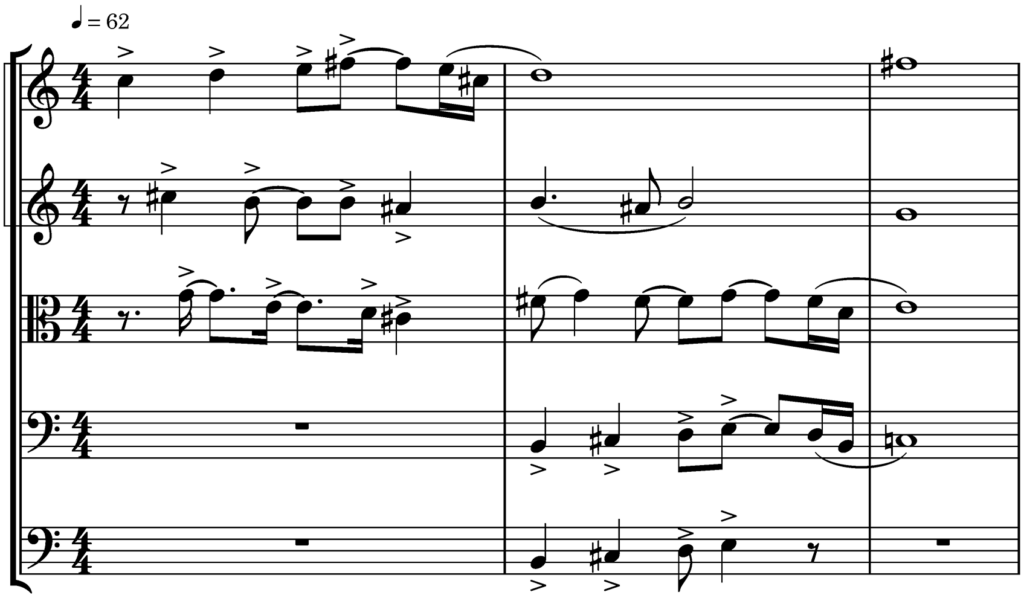
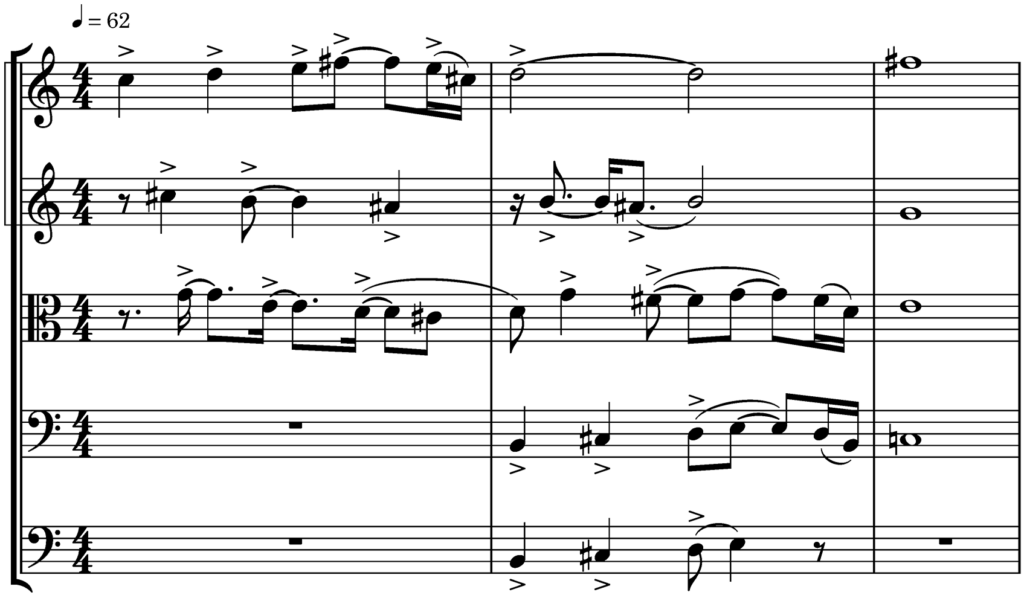
Above is an example of how I am refining an old idea. I wanted to create this staggered effect between the instruments – two violins, a viola, a cello, and a double bass – but didn’t really take it all the way in the old version. In the new, I have brought the staggered writing more clearly over into the second bar between the second violin and the viola. I also switched the sixteenth note offset over to the second violin, giving the viola the eighth note offset instead. The third beat of the second bar is now the final accented beat, instead of the offbeat as in the old version. This makes for a more graceful move into the third bar.
The second example below shows how I in some places tighten the music up by shortening note values, or even cutting the number of beats in a bar.


Already when I wrote the original version, I strived to follow the natural flow and rhythm of speech. While I believe I succeeded at least partially even back then, the rests in the old version feel unnatural, like they disrupt the flow of the singing.
The new version is written in both 3/4 and 4/4, cutting out the superfluous rests and improving the vocal line significantly even if the changes are rather small. This quote comes from Luke 1:36–37: “Even Elizabeth your relative is going to have a child in her old age. /…/ For no word from God will ever fail.”
In the third example, I have extended the length of one of the bars, compared to the original, instead of shortening it. The soloist here is accompanied by a string quintet (same setting as in Ex. 1) with the viola doubling the voice melody.
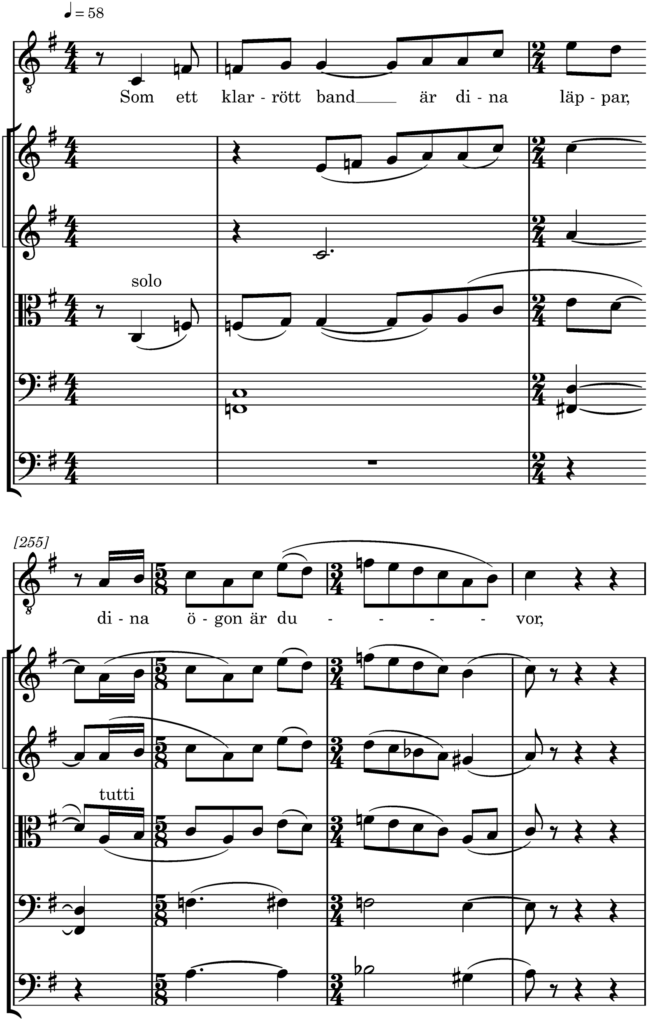
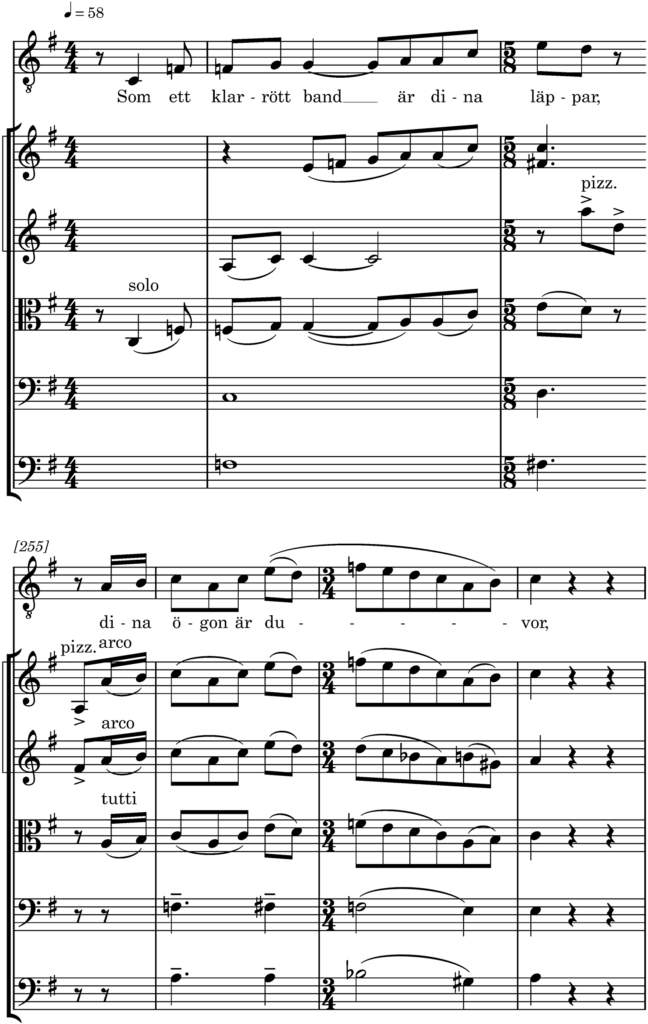
The 2/4 bar followed by a 5/8 bar in the original version feels quite natural with the way the lyrics flow, but I saw two reasons for changing it to two 5/8 bars instead. The text is from Song of Songs 4:1, 4:3: “Your lips are like a scarlet ribbon; /…/ your eyes behind your veil are doves.” The first and foremost reason is that it creates a natural break between the two phrases. I wanted to give the loving metaphors a little more space. Second, and arguably less important, I also wanted to cut down on the number of time signature changes in the work as a whole.
In addition, I added some new details to the string parts. In the first bar, instead of beginning with a rest, the second violin gets two eighth notes that connect the viola’s melody from the previous bar with the first violin’s rising figure starting on the second beat. Together, starting on the viola’s low C3 and ending on the first violin’s initial E4, the notes spell an F major 7th chord. I also added a sweet little pizzicato line to make sure the added eighth note beat (in the former 2/4 bar) doesn’t come across as empty space.
The fourth example is perhaps better understood in the full context of the music, especially if you can see the complete choral parts, but I hope this excerpt will get the point across anyway. Take a look at this triumphant solo vocal phrase:
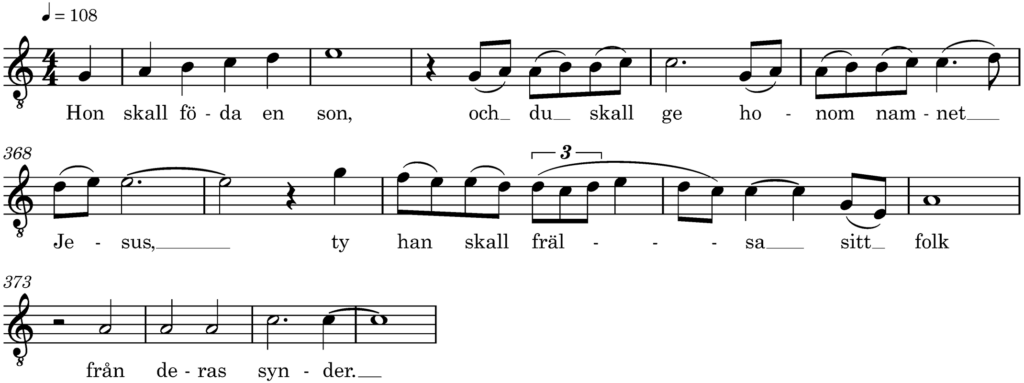
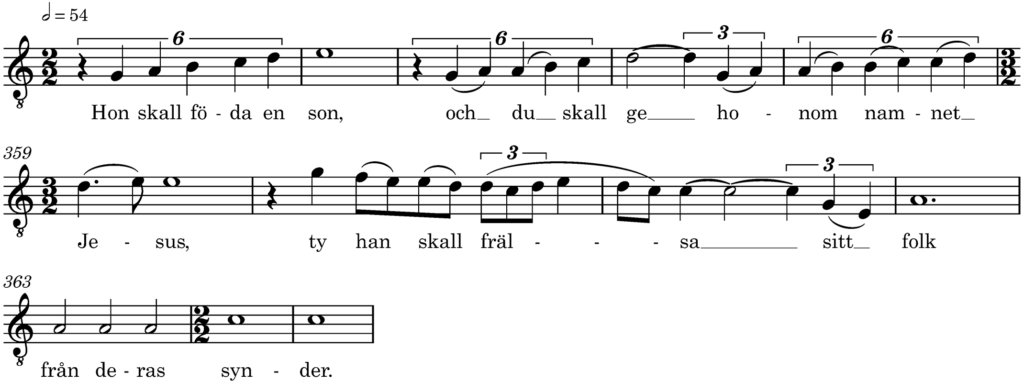
Underneath this tenor solo, the choir and organ lay a wordless, murmuring chordal accompaniment. It is supposed to evoke a sensation of simultaneous stability and unsteadiness, as if you dream that you are flying, which is both unsettling and exhilarating at the same time.
The original version is written in 4/4, which is fine, but can result in a “choppier” interpretation, if every beat of the bar is marked out by the conductor. Changing it the time signature to 2/2 means that the bars are the same length, but divided into two beats instead of four, bringing a little more “floatiness” to the way the music is written. Essentially, I think that this time signature better communicates my musical intention than the old one did.
Along the same line, I have changed the rhythm of the melody line from the stricter, almost disciplinary fourth and eighth notes to the (once again) the “floatier”-feeling fourth note sextuplets. The lyrics come straight out of Matthew 1:21: “She will give birth to a son, and you are to give him the name Jesus, because he will save his people from their sins.” I kept the “because he will save his people” part basically the same, save for extending the last note of the word “save”. The way the new version is written, the music here almost feels ornamental now, further accentuating the importance of the words.
And finally, my fifth and final example is actually a bit embarrassing:
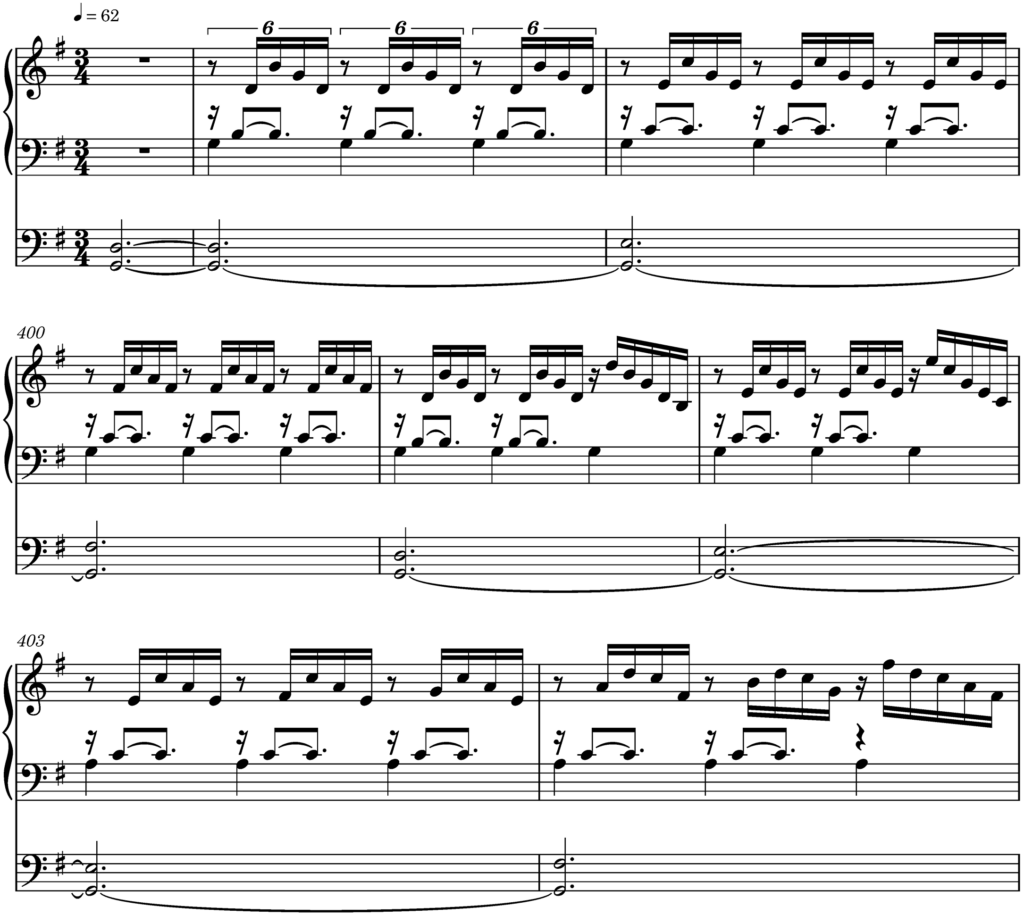
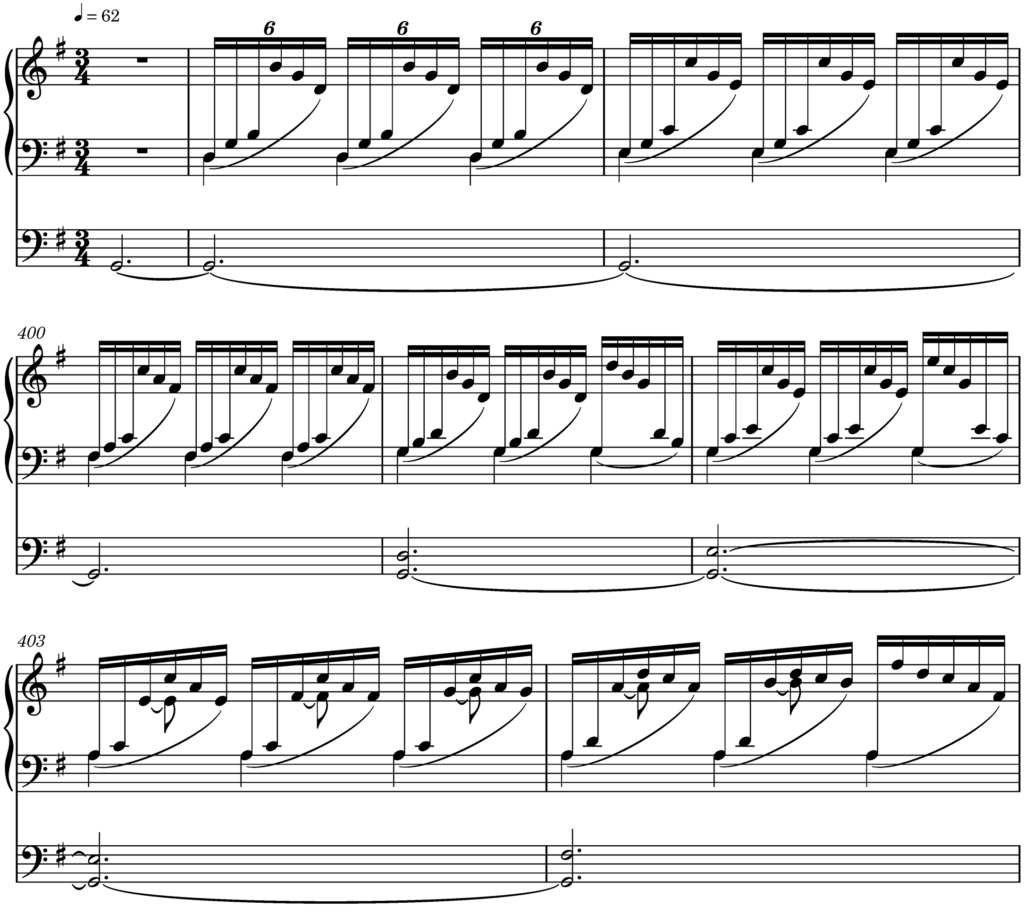
In the old version, the notation is inelegant and unnecessarily hard to parse. To be fair, I have seen similarly poor writing in other published scores, where the composer themselves supplied the final proof instead of a professional notesetter. While I wouldn’t dream of claiming to be as competent as a professional notesetter even today, I do think that my notation skills have improved greatly since 2013, as you hopefully agree judging from this side-by-side.
In the new version, the sextuplet groups are properly beamed together across both staves, making the music much easier to read and interpret. This accompaniment continues throughout almost the entire movement, so it makes an enormous difference. The one major change between the old version and the new is that only the left hand’s first note is held down in the new version.
The new version is far more elegant, using the one sustained note in the left hand together with a two-note pedal part to achieve a similar result as the comparably brutish older version.
